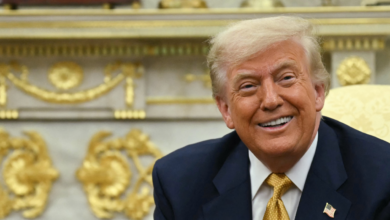Fed officials were cautious about inflation as they agreed rate cuts

Open the White House Watch newsletter for free
Your guide to what Trump’s second term means for Washington, business, and the world
Some senior Fed officials were in favor of keeping borrowing costs unchanged last month, highlighting concerns among policymakers that high inflation remains a threat to the U.S. economy.
The Federal Open Market Committee, which sets interest rates, cut borrowing costs for the first time this year in September, lowering the federal funds target range by a quarter point to 4-4.25 percent amid signs of a weak jobs market.
However, minutes of the mid-September vote showed that “a small number” of FOMC members would have supported a decision to keep borrowing costs unchanged as inflation was at risk of remaining above the central bank’s target.
Progress toward the 2 percent target “has stalled this year as inflation readings have increased,” the meeting minutes said, adding that a few members “expressed concern that longer-term inflation expectations may rise if inflation does not return to its target in time.”
The Fed’s preferred measure of inflation came in at 2.7 percent in the year through August – slightly higher than July’s reading of 2.6 percent.
The two-year Treasury yield, which moves with interest rate expectations, rose on the release of the minutes, rising 0.03 percentage point to 3.59 percent Wednesday afternoon.
The minutes highlight that Fed officials may be more divided about what happens to monetary policy than the initial decision suggested.
The 12 voting members of the Federal Open Market Committee backed the cut by 11-1, while Stephen Meiran, an ally of President Donald Trump and an economic adviser who joined the Fed just before the meeting, backed a larger move of a half-point.
The committee has a total of 19 members, with seven of the 12 regional chairs unable to vote at any time.
Projections released at the time of the meeting showed that a narrow majority of committee members support cuts of at least a quarter of a point later this year.
Miran was alone in predicting much deeper cuts from the central bank, while one committee member thought borrowing costs should end the year a quarter of a point higher than they are now.
While inflation rose in 2025 on the back of Trump’s tariffs, Fed officials who favor further cuts believe that the inflationary impact of the president’s trade policies will still be limited to US imports and will have no spillover effects.
Meanwhile, a sharp decline in non-farm payrolls numbers has led to concerns that the US labor market may be about to weaken significantly.
The Fed is targeting full employment along with inflation of 2 percent.
The decision to cut interest rates came after months of pressure from Trump, who rebuked Federal Reserve Chairman Jay Powell, calling him a “dope” and that it was “too late” to ease monetary policy.
Trump has sought to increase his influence over the central bank, although his efforts to immediately fire Governor Lisa Cook faltered due to a Supreme Court ruling earlier this month.
Additional reporting from Kate Duguid in New York
2025-10-08 19:27:00




